
By: Allvue Team
August 24, 2022
We’ve provided an overview of alternative investments on the Allvue blog, and now we’re digging into a new question – what is private capital?
In this article, we’re zooming in one level on alternative investments and breaking down private capital’s definition, fund structure, market participants, and the strategies that it encompasses. Let’s dive in.
Private capital definition
The term “private capital” describes a collection of investment strategies that deal in private assets as opposed to publicly traded ones, like stocks and bonds. These strategies or asset classes that fall under private capital include private equity, venture capital, private credit, real estate, and infrastructure.
Historical context and evolution of private capital
The origins and evolution of private capital trace back to the growth of private equity in the 1980s. This period marked a significant shift in investment strategies, leading to the development of various asset classes within private capital. The expansion of these strategies was further accelerated by the Global Financial Crisis in 2008, as investors sought more diversified and less volatile investment options. Understanding this historical context provides valuable insights into the current landscape and future potential of private capital investments.
How are private capital funds structured?
Private capital investments are typically managed through a closed-ended fund structure . These managers (“general partners” or GPs) choose one or multiple private capital strategies and target investors (“limited partners” or LPs) as they raise capital for their funds.
Private capital funds are known for their diverse structuring options, which include commingled funds, funds of funds, and separately managed accounts. Each structure caters to different investor needs and objectives. For example, a commingled fund pools resources from multiple investors, whereas separately managed accounts are tailored to individual investors. The terms of these funds, such as management fees, typically around 2%, and performance fees, often set at 20% of the profits, are crucial for investors to understand. These terms not only define the cost structure but also align the interests of fund managers and investors.
Private capital fund structure, visualized
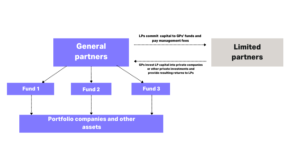
Fundraising
As GPs prepare to launch a new fund, they begin the fundraising process and seek out large institutional investors and ultra-high-net-worth individuals to commit capital. Private capital investments are largely out of reach for the average retail investor, as the minimum investment required by most private capital managers falls in the $5 million to $25 million range. Private capital funds are highly illiquid investments, and in most cases limited partners are committing to locking up their capital for seven to 10 years. But by stomaching such illiquidity, limited partners are likely to see outsized returns that wouldn’t exist in public markets.
Investment period
Once the fundraising period closes and the investment period begins, general partners begin seeking out and conducting deals that meet the planned strategy for their fund, such as lending to a distressed business, buying up a tech startup or financing an infrastructure project. These deals make up the fund’s assets, or, in the case of equity investments, portfolio companies. Over the course of the fund’s lifetime, the general partner will put out capital calls to their investors to draw on their committed capital, or dry powder, in order to finance these deals. In the case of private equity and venture capital, as they hold these assets, they create value in them by making operational changes, completing further mergers and acquisitions, divesting business units, or by restructuring them.
Wind down
As the fund begins winding down, general partners will exit from their investments to begin reaping returns to be dispersed to limited partners. For strategies like private equity and venture capital, this often involves taking a business public via in IPO, or it could also involve selling it off to a new buyer. For managers, this means reaching the completion of the funds’ loan payment plans for its portfolio companies.
Average private capital fund timeline
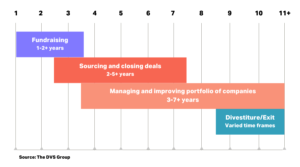
Lifecycle of funds
The lifecycle of a private capital fund is a critical aspect to understand. These funds are typically closed-end investment vehicles with a finite lifespan, often around 10 years. During this period, investors commit their capital without the option for early redemption. The lifecycle includes stages such as fundraising, investment, management, and finally, exit, where returns are realized and distributed to investors. This structured approach allows for strategic long-term investment planning and value creation.

Active management role of private capital fund managers
In contrast to public market fund managers, private capital fund managers play a much more active role in the management of their investments. This involves not just strategic investment decisions but also direct involvement in the operational, financial, and strategic development of the portfolio companies or assets. This hands-on approach is a defining characteristic of private capital management and is key to driving value and growth in the investments.
What are the different types of private capital?
As established, private capital is an overarching term representing the multiple different strategies that asset managers follow to set up funds, attract investors, and then invest in private assets. These are the main private capital strategies:
Private equity
Private equity as an investment strategy involves making investments in mature businesses by buying up equity, aka ownership in the business itself. The private equity manager then oversees value creation within the business, whether by restructuring, making operational improvements, or otherwise. By the end of a private equity fund’s lifetime, the manager will have exited the investments made with the fund’s working capital. All its holdings will either be sold off or taken public, and if the fund is successful, it will have made a profit from doing so. These profits, “returns”, are then paid out to the fund’s investors.
Venture capital
Venture capital is a form of private equity, but it contains some key differences. Venture capital still involves buying equity in businesses as an investment, but it focuses on investing in early-stage companies, often specifically in the tech industry. It also tends to involve smaller investments, as these early-stage companies are a higher-risk investment with more unknowns compared to a more mature business. We can see this in a comparison of the average private equity fund size – $1.7 billion – versus the average venture capital fund size – $195 million.
Private debt
Private debt (also referred to as private credit) works similarly to private equity, except rather than buying equity – or ownership – in a business, the investment lies in making loans to businesses that need capital. Private debt managers generate returns via scheduled interest payments and repayment of the original principle. Debt sits above equity in the capital structure, and because of this, private debt is generally seen as a less risky investment than private equity and venture capital. There are multiple classes of private debt with different levels of risk, some of which include senior debt, mezzanine debt and distressed debt.
Real estate
Real estate investment managers raise capital from investors to make investments in real estate properties by developing new properties, operating and improving existing ones, and then selling them in order to generate returns.
Infrastructure
Infrastructure investment managers invest in physical asset projects, such as the building of roads, bridges, or energy infrastructure. Private infrastructure investments are generally seen as a low volatility asset class as they are often tied to macroeconomic factors like inflation or population growth.
Where do debt and equity sit within the capital structure?
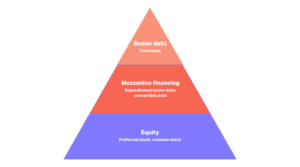
INFOGRAPHIC: How to complete a capital call in 10 minutes
How has private capital grown?
Private capital has seen impressive growth over the last few decades, but its explosion in popularity can really be credited to the Global Financial Crisis of 2008. As public markets cratered, institutional investors requiring outsized returns on their market-moving quantities of capital could no longer keep such a large portion of their portfolios in equities. And as interest rates were adjusted to near zero, fixed income also became an unattractive option for generating alpha.
But private capital doesn’t align with the volatility of the public markets. While many investors had overlooked private capital in the past for its significant levels of illiquidity, the asset class was suddenly seen as a haven from the uncertainty of more traditional investment vehicles.
We’re a long way from the 2008 financial crisis now, but private capital has become a staple in most large investors’ portfolios. Its influence just keeps growing, with the total value of the entire private capital market existing beyond $7 trillion.
Private capital fundraising growth
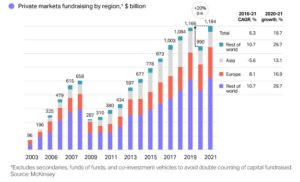
What’s the difference between private capital and alternative investments?
Private capital is a subset of alternative investments. While the broad term “alternatives” could encompass any kind of asset that is an alternative to listed stock or fixed income, such as cryptocurrency or collectibles, private capital is just one form of alternative investment. Private capital describes the funds offered by investment managers that pursue one or more specific private capital strategies when investing.
Where does private capital sit relative to alternatives investments?
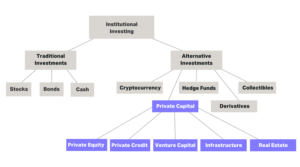
What is the difference between private capital and private equity?
While the terms “private capital” and “private equity” are often used interchangeably, they are not exactly the same idea. Private equity is considered a subset of private capital. However, private equity is by far the largest and most popular private capital strategy, and the industry has tripled in size over the last decade from $2 trillion to more than $6 trillion.
How can Allvue help private capital managers and investors?
With a complex asset class like private capital, a holistic view of your private short of essential. And yet, due to the manual nature of private capital investments, it can be challenging to maintain a continuous grasp on your investment operations from pipeline management all the way through to accounting and reporting processes.
Allvue provides software solutions for all market participants in the private capital space. From limited partners to fund administrators to venture capital managers and beyond, Allvue helps you eliminate the boundaries between systems, information, and people, helping to get the information you need when you need it.
Ready to learn more about how Allvue’s solutions can support private capital investment operations? Research our solution sets or reach out for a demo below.







